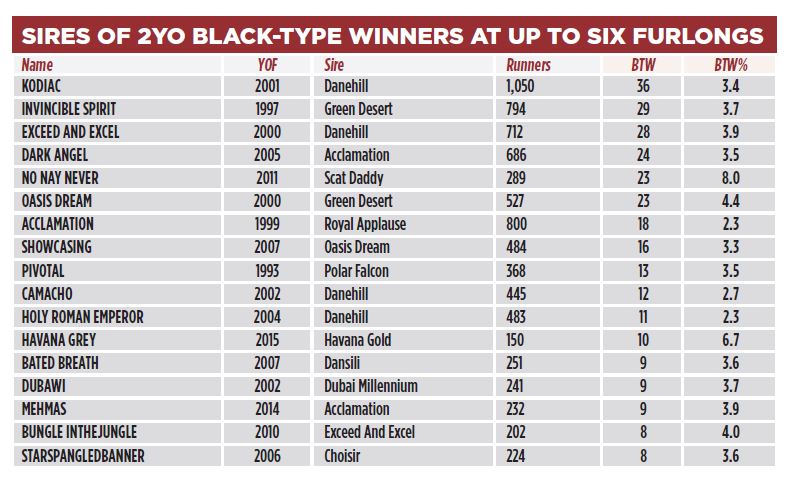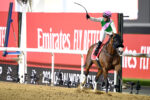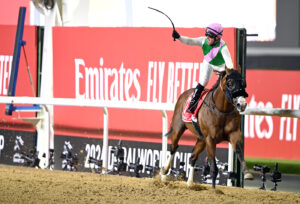As the 2024 flat season beckons, perhaps it is a good opportunity to take a ‘state of the nation’ review of those sires whose wheelhouse is the production of five- and six-furlong two-year-old stakes winners.
This cohort of stallions are quite often maligned because as a general rule they tend to have shorter racing careers and inevitably fail to stack up against their middle-distance counterparts in terms of racecourse longevity and class. But they have always been around and as long as our European pattern continues to bestow Group and Listed status on juvenile five- and six-furlong races they will remain. And, yes, there is bound to be ever more specialisation among this group of stallions.
Way back at the beginning of the Pattern in the early 1970s, I can recall Habitat being one of the first major sources of speed and precocity. The son of Sir Ivor’s sire Sir Gaylord, who stood at Grangewilliam Stud under the Airlie banner, never looked back after his first crop contained Habat, winner of the Group 1 Middle Park (one of four for his sire), Group 2 Mill Reef and Group 3 Norfolk Stakes, plus Bitty Girl, who secured the Group 2 Queen Mary, Group 3 Lowther and Group Molecomb Stakes. In the end Habitat ended up with 30 career stakes-winning two-year-olds at five and six furlongs which would place him second on our current leader board, a remarkable feat considering the small crops back then. His strike rate was above ten per cent as was that of Danehill, another sire that would have slotted in at 28 amongst our current top ten.
The crucial difference between this pair and some today’s most successful juvenile speed sires is that they also were sources of excellent three-year-olds and older horses. Habitat sired Habibti (Timeform 136), Marwell (133), Rose Bowl (133) and Flying Water (132); the first two were top-class sprinters and the latter pair brilliant at a mile and ten furlongs. Has any sire ever come up with a more talented bunch of fillies? The same is true of Danehill.
Today’s most successful sources of speed and precocity are perhaps a bit more specialised. The one that looks sure to climb to the very top in due course is Coolmore’s No Nay Never. And it will not take long as the four active sires above him are aged 19 and older. This son of Scat Daddy has, by modern-day standards, an enviable strike rate of eight per cent stakes winners to runners among his juvenile five- and six-furlong stock.
It is quite revealing that 33 (67 per cent) of No Nay Never’s 49 stakes winners were two-year-old stakes winners. But he retains the ability to sire some that will go on to better things at three and four, such as his Group 1 Middle Park Stakes scorer Ten Sovereigns who progressed to win the Group 1 July Cup at three, or his Group 1 Cheveley Park Stakes heroine Alcohol Free, who proved both progressive and adaptable by winning the Group 1 Sussex Stakes and Group 1 Coronation Stakes over a mile as well as the Group 1 July Cup over six.
Another young upstart that will surely become a potent challenger to No Nay Never among the most consistent suppliers of two-year-old five- and six-furlong stakes winners in the coming years is Whitsbury Manor Stud’s Havana Grey. Like No Nay Never, Havana Grey has an excellent strike-rate among this cohort with a success rate of 6.7 per cent even though he has only ten stakes winners on the board at this point in time. All things being equal, it is not hard to visualise Group 1 races like the Prix Morny, Middle Park and Cheveley Park Stakes playing a central role in Havana Grey’s future success. After all, like the aforementioned Habitat and No Nay Never, he has already opened his Morny-Middle Park account with the exciting Vandeek.
Back in 1990, the successful British sire Kris provided the first two home in the Group 1 Prix de Diane over 2,000 metres. The winner Rafha, trained by Sir Henry Cecil for Prince Faisal, had previously won the Lingfield Oaks Trial over 12 furlongs. Not many would, therefore, have predicted the important role she would come to play in the production of so many juvenile stakes winners through her sons Invincible Spirit and Kodiac. With strike-rates half that of No Nay Never, both Invincible Spirit and Kodiac have relied on their longevity to climb to the pinnacle of this particular ranking. And kudos must go to both for doing so.
Although he has a lower strike-rate than his older three-parts brother, Kodiac’s achievement must be appreciated more than his brother’s for no other reason that he started out and stayed at a much lower fee. Interestingly, 56 per cent of Kodiac’s stakes winners are two-year-olds, compared to Invincible Spirit’s 33 per cent.
Our leader board has very much a Danzig-line theme to it, through his sons Danehill and Green Desert. In his own lifetime, Danzig sired 30 five- and six-furlong stakes-winning two-year-olds but he was a whole lot more than just a sire of speedy juveniles and indeed they account for only 22 per cent of all his stakes winners. So, to get to 30 was a significant achievement.
His son Danehill appears in the male line of seven sires on our list and we must acknowledge the enormous contribution made by Exceed And Excel, who actually heads the equivalent ranking in his native Australia.
Green Desert’s contribution comes via Invincible Spirit and Oasis Dream, whose 23 stakes winners have come at a healthy rate of 4.4 per cent from runners, again a commendable achievement considering he had other strings to his bow. And it looks very much that his son Showcasing is the sire set to carry his name forward in this particular arena.
We must also give plenty of credit to the Royal Applause line, represented here by Acclamation, and his sons Dark Angel and Mehmas. Mehmas is another of the younger generation of sires that is bound to shoot up leaderboard in the coming years, as he is about to be represented by the first of a succession of large crops brimming full of quality.




